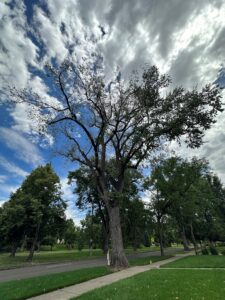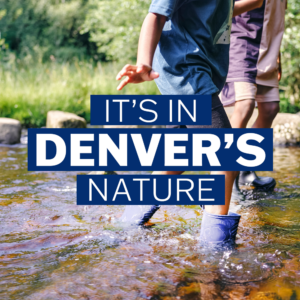Dutch Elm Disease: What Denver Residents Need to Know
Dutch elm disease is a fungal disease vectored in part by the elm bark beetle or spread through overlapping roots among elm trees. The disease is known to be lethal to elm trees, and it can rapidly infect neighboring trees of the same species. This disease was first discovered in the U.S. nearly a century ago – brought to the U.S. in European wood that was imported for fine furniture-making. It continues to threaten our elm trees today. Dutch elm disease is essentially incurable, so the best course of action is a hefty combination of diligence and prevention.
A term that may be new to readers is vector which comes from the Latin, vehere – which means “to carry.” Think about it like this: a vector is a bug that carries disease to people and animals. For example, consider how mosquitos and ticks spread diseases that can harm humans and pets. A beetle vector is a beetle that transmits disease, but to plants and trees. Elm bark beetles are referred to as beetle vectors of elm trees. They feast under the elm tree bark, which then spreads fungus into the tree’s “veins,” making the tree very sick and rapid decline soon follows.
These infections are worse when they take root in early spring, when the wood is still moist. But it’s still destructive in the summer. Either way, without early preventative mitigation, the tree dies.
 When the tree becomes infected, the leaves in the high branches – or crown – begin to yellow and wilt. Quickly, the leaves turn brown, curl up and then the entire branch dies. Branch by branch, the disease spreads until the entire tree dies. The American Phytopathological Society (APS) shares this simple-to-understand illustration on the cycle of Dutch elm disease:
When the tree becomes infected, the leaves in the high branches – or crown – begin to yellow and wilt. Quickly, the leaves turn brown, curl up and then the entire branch dies. Branch by branch, the disease spreads until the entire tree dies. The American Phytopathological Society (APS) shares this simple-to-understand illustration on the cycle of Dutch elm disease:
Sadly, if you’ve already identified the disease, it may be too late for the tree. But there are still some steps you can take to keep the fungus from spreading.
 Like most tree ailments, it’s better to prevent the arrival of an illness than to cure a diseased tree. Prevention involves following good cultural practices, such as not planting too many of the same species of tree in a row, proper watering, avoiding damage to the tree, mulching, and rotational pruning. Property owners should not attempt to diagnose, prune or remove elms that may be infected, as that may unintentionally spread the disease due to beetle or fungus existing in the debris. It’s always best to have a licensed tree contractor perform tree work and remove all debris.
Like most tree ailments, it’s better to prevent the arrival of an illness than to cure a diseased tree. Prevention involves following good cultural practices, such as not planting too many of the same species of tree in a row, proper watering, avoiding damage to the tree, mulching, and rotational pruning. Property owners should not attempt to diagnose, prune or remove elms that may be infected, as that may unintentionally spread the disease due to beetle or fungus existing in the debris. It’s always best to have a licensed tree contractor perform tree work and remove all debris.
If Denver residents rally to prevent the spread and save the elms, we’ll see success. Below are a few photos of a local tree with Dutch elm disease at the crown. Look familiar? If you see one in a public right of way, please call 720-913-0651 or email forestry@denvergov.org.

 In the spring of 2023, Denver Parks and Recreation and the Office of the City Forester conducted a comprehensive community-wide survey to gather insights from residents regarding their priorities concerning trees and the urban forest across town. This valuable information is currently being utilized to craft the city’s inaugural Urban Forest Strategic Plan. The plan encompasses all trees within the city, whether on public or private property, and aims to enhance existing goals, introduce new ones, and establish a shared and fair vision for the future of the urban forest.
In the spring of 2023, Denver Parks and Recreation and the Office of the City Forester conducted a comprehensive community-wide survey to gather insights from residents regarding their priorities concerning trees and the urban forest across town. This valuable information is currently being utilized to craft the city’s inaugural Urban Forest Strategic Plan. The plan encompasses all trees within the city, whether on public or private property, and aims to enhance existing goals, introduce new ones, and establish a shared and fair vision for the future of the urban forest. With more people relocating to Denver, warming weather and more frequent periods of drought – we are tapping into our most precious resource like never before. Currently, about 40 percent of water in Denver is used for outdoor landscapes but water isn’t an unlimited resource. That’s why Denver Parks & Recreation
With more people relocating to Denver, warming weather and more frequent periods of drought – we are tapping into our most precious resource like never before. Currently, about 40 percent of water in Denver is used for outdoor landscapes but water isn’t an unlimited resource. That’s why Denver Parks & Recreation